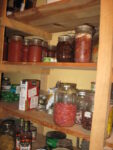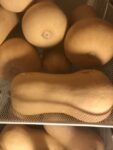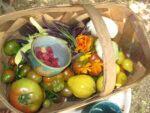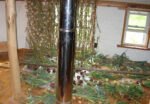A version of this column first ran in the Roane County (WV) Reporter and Times Record. Support local journalism! Subscribe to your local newspaper. This is one of a series of blogs for new gardeners. Read the rest: Part 1. Part 2. Part 3. Part 4. Part 5. Part 6. Part 7. Part 8. Part 9.

One way to get the most out of limited garden space is to plan for a second crop in the same space as one you harvest early. (Above: Young butternut squash plants in my onion bed.)
One set of crops that are done early and thus make way for others is the salad bed: lettuce, spinach and radishes, often planted together. These will all bolt (go to seed) when it gets hot, and get bitter (or woody in the case of radishes). This may happen in late June. The brassicas—cabbage family members—also decline in heat, but some gardeners leave broccoli in place and continue to harvest side shoots after the main head is gone.
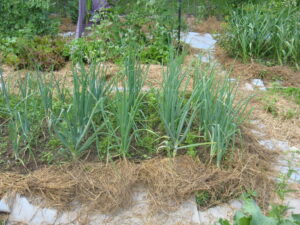
Carrot plants in between onion rows.
The main crops that come out early and leave room for later ones, for me, are the alliums—onions and garlic. (Leeks are alliums too but even though I start them in the middle of February, they aren’t ready till August, and I don’t devote a lot of space to them.) Onions and garlic get a full bed apiece plus the two beds of onions which stripe with carrots, and the two garlic grids in the gaps of which I plant peppers and sweet potatoes. Yes, we eat a lot of onions and garlic, and in the first couple of weeks of July they are all over my house drying—we’ve never had trouble with werewolves or vampires! Now that I live on a ridge I find they’re ready to pull a week earlier than when I gardened in the holler—I pull the garlic the last week or so of June and the onions the first week of July.
As soon as the alliums are out of the ground, I plant the late crop (I may improve the soil first if I think it needs it). Mostly I plant dry beans and peanuts. Yes, you can grow peanuts around here, as long as you get them in by early July. I get my seed from Southern Exposure Seed Exchange in Virginia, and their varieties vary from 110 to 130 days to maturity. I’ve grown them four or five years and they have always matured okay—of course, we’ve had some very late fall frosts in recent years.
Peanuts are fun because they are legumes, like peas and beans, which means they fix nitrogen, and the nuts are technically a kind of bean—but unlike any other, they grow underground. The plants make little yellow pea-type flowers, and then send “pegs” down from these flowers into the ground and the peanuts develop secretly down there. The day before it frosts, or when you see the plants beginning to yellow and sag, pull them up and hang them in a dry place for a couple of weeks, then pluck off the peanuts and dry them some more. You can store them in the shells, or shell and roast them.
I’ve grown several kinds of dry beans, and many of these only need 75 to 90 days to mature, so they’re a good choice for a succession crop. Pull them when the pods are dry, if possible, and then hang them to dry completely before shelling them and storing in jars. They’re a good choice for emergency food as they have a lot of protein and will keep indefinitely without requiring electricity or special treatment.
Of course, you can also grow snap beans, which need even less time; we don’t eat a lot of beans so I only grow one batch on the same fence on which I grow my peas in spring. I prefer pole beans as you don’t have to get on your knees to pick them, they don’t drag in the mud, and they produce for a long time. But bush beans have the virtue of being ready to begin harvest quickly, and they don’t need support. I generally choose purple ones because I figure they’re slightly easier to pick. Some people make big teepees or tripods for pole beans to climb on. But I just plant mine along the other side of the stretch of field fence from where my peas are bearing…by the time the peas are turning yellow and getting ripped out, the beans are up and beginning to climb.
I have succeeded a couple of times growing watermelons after garlic, but only by choosing the shortest-season ones—Sugar Baby or Early Moonbeam. Another possibility is summer squash—I usually have one hill, but may plant a late one to take over when the first one is old and tired, with ratty leaves.
There is one cover crop good for holding space and keeping it weed-free during the warm season: buckwheat. It flowers in about a month, and you can pull it then or let the bees enjoy it. If you let it seed itself you will have buckwheat volunteers for awhile, but the nice thing about buckwheat is how easy it is to remove.
Then there are the fall crops; these tend to be a bit of a gamble, because you have to start them when it’s still hot in order to have them mature before it frosts too hard for them. Peas, salad items and brassicas are the most common.
